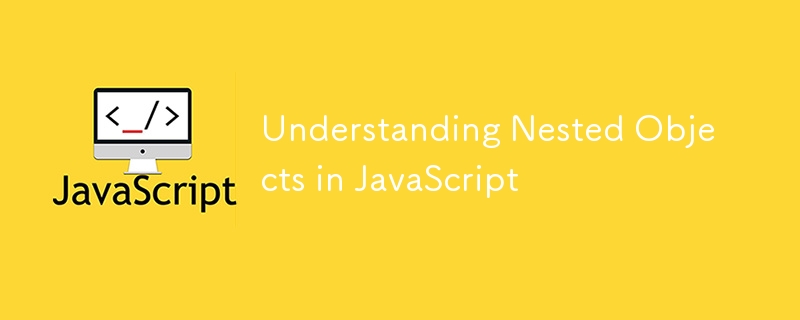JavaScript のネストされたオブジェクトを理解する

オブジェクトは、JavaScript 開発者として扱うものであり、言うまでもなく、これは TypeScript にも当てはまります。 TypeScript では、オブジェクト プロパティの型定義を定義する複数の方法が提供されます。この記事では、簡単な例から始めて高度な型定義に進みながら、それらのいくつかを見ていきます。
JavaScript のネストされたオブジェクトは、他のオブジェクトまたは配列をプロパティとして含むオブジェクトです。これにより、現実世界のエンティティをより効果的に表現できる複雑なデータ構造の作成が可能になります。
JavaScript では、オブジェクトを他のオブジェクト内にネストできます。これは、オブジェクトのネストまたはオブジェクトの合成とも呼ばれます。オブジェクトのネストを使用すると、オブジェクト内でオブジェクトを編成することで、複雑なデータ構造を作成できます。
ネストされたオブジェクトの作成
ユーザー プロファイルを表すネストされたオブジェクトの簡単な例を次に示します:
const userProfile = {
username: "irena_doe",
age: 30,
contact: {
email: "[email protected]",
phone: {
home: "123-456-7890",
mobile: "987-654-3210"
}
},
preferences: {
notifications: true,
theme: "dark"
}
};
例えば:
userProfile オブジェクトには、ユーザー名、年齢、連絡先などのプロパティがあります。
contact プロパティ自体は、電子メールと電話を含むオブジェクトです。
Phone プロパティは、自宅番号と携帯電話番号を含む別のネストされたオブジェクトです。
ネストされたオブジェクトのプロパティへのアクセス
ネストされたオブジェクト内のプロパティにアクセスするには、ドット表記または括弧表記を使用できます。ユーザーの携帯電話番号にアクセスする方法は次のとおりです:
const mobileNumber = userProfile.contact.phone.mobile; console.log(mobileNumber); // Output: 987-654-3210
ネストされたプロパティを変更することもできます。たとえば、テーマの設定を変更したい場合:
userProfile.preferences.theme = "light"; console.log(userProfile.preferences.theme); // Output: light
ネストされたオブジェクトでの型の使用
TypeScript を使用する場合、ネストされたオブジェクトの型を定義して型の安全性を確保できます。 userProfile オブジェクトのタイプを定義する方法は次のとおりです:
type UserProfile = {
username: string;
age: number;
contact: {
email: string;
phone: {
home: string;
mobile: string;
};
};
preferences: {
notifications: boolean;
theme: string;
};
};
const user: UserProfile = {
username: "irena_doe",
age: 30,
contact: {
email: "[email protected]",
phone: {
home: "123-456-7890",
mobile: "987-654-3210"
}
},
preferences: {
notifications: true,
theme: "dark"
}
};
この TypeScript の例では、UserProfile 型で userProfile オブジェクトの構造を定義し、すべてのプロパティが正しく型指定されるようにします。
これは、JavaScript のネストされたオブジェクトの別の例です。
図書館システムを表す、より複雑な例を見てみましょう。各書籍には、著者、出版社、ジャンルなどのさまざまな詳細が含まれています。
ネストされたオブジェクトは、type キーワード自体を使用して定義できます。 TypeScript は、ネストされたオブジェクトの型定義を型定義に抽象化することもできます。インデックス署名は、オブジェクトが持つプロパティの数は不明だが、オブジェクトのプロパティの種類は確かである場合に使用できます
図書館システムのネストされたオブジェクトの定義
このシナリオでネストされたオブジェクトを構造化する方法は次のとおりです:
const library = {
name: "Central City Library",
location: {
address: {
street: "123 Main St",
city: "Central City",
state: "CC",
zip: "12345"
},
coordinates: {
latitude: 40.7128,
longitude: -74.0060
}
},
books: [
{
title: "JavaScript: The Good Parts",
author: {
firstName: "Douglas",
lastName: "Crockford"
},
publishedYear: 2008,
genres: ["Programming", "Technology"],
availableCopies: 5
},
{
title: "Clean Code",
author: {
firstName: "Robert",
lastName: "C. Martin"
},
publishedYear: 2008,
genres: ["Programming", "Software Engineering"],
availableCopies: 3
}
],
totalBooks: function() {
return this.books.length;
}
};
ネストされたオブジェクト構造を詳しく見てみましょう
- Library オブジェクト: ライブラリ全体を表し、名前、場所、書籍などのプロパティが含まれます。
- Location オブジェクト: 住所と座標のネストされたオブジェクトが含まれます。
- 住所には、番地、都市、州、郵便番号が含まれます。 座標には緯度と経度が格納されます。
- Books 配列: 複数の書籍オブジェクトを保持する配列。それぞれに以下が含まれます:
- タイトル: 本のタイトル。
- Author オブジェクト: 著者の firstName と lastName を含むネストされたオブジェクト。
-出版年: 本が出版された年。
- ジャンル: 本が属するジャンルの配列。
-利用可能部数: 利用可能な部数を示す数値。
データへのアクセスと操作
このネストされたオブジェクトにはさまざまな方法でアクセスして操作できます。最初の本の著者を取得する方法は次のとおりです:
const firstBookAuthor = library.books[0].author;
console.log(`${firstBookAuthor.firstName} ${firstBookAuthor.lastName}`);
// Output: Douglas Crockford
新しい本をライブラリに追加するには:
library.books.push({
title: "The Pragmatic Programmer",
author: {
firstName: "Andrew",
lastName: "Hunt"
},
publishedYear: 1999,
genres: ["Programming", "Career"],
availableCopies: 4
});
オブジェクト内でのメソッドの使用
オブジェクト内で定義されたメソッドを利用することもできます。たとえば、本の総数を取得するには:
console.log(library.totalBooks()); // Output: 3
この例では、ネストされたオブジェクトを使用して、図書館システムなどの複雑なデータを表すより包括的な構造を作成する方法を示します。関連情報をまとめて整理することで、有意義な方法でデータを簡単に管理し、操作できるようになります。
別のネストされた例
コードの構成と保守性を向上させるために、ネストされたオブジェクトを別のタイプに抽象化できます。このアプローチにより、Caterer タイプを個別に定義し、Train タイプ内で使用することができます。 TypeScript でこれを行う方法は次のとおりです:
// Define the type for Caterer
type Caterer = {
name: string; // Name of the catering company
address: string; // Address of the catering company
phone: number; // Phone number of the catering company
};
列車タイプの定義
次に、Caterer プロパティに Caterer タイプを使用する Train タイプを定義します。
// Define the type for Train
type Train = {
model: string; // Model of the train
trainNumber: string; // Unique train number
timeOfDeparture: Date; // Departure time
timeOfArrival: Date; // Arrival time
caterer: Caterer; // Reference to the Caterer type
};
電車オブジェクトの例
これで、ケータリング業者の詳細を含む列車タイプのインスタンスを作成できます。
// Example of a Train object
const train: Train = {
model: "Shinkansen N700",
trainNumber: "S1234",
timeOfDeparture: new Date("2024-10-25T09:00:00Z"),
timeOfArrival: new Date("2024-10-25T11:30:00Z"),
caterer: {
name: "Gourmet Train Catering",
address: "123 Culinary Ave, Tokyo",
phone: 1234567890,
},
};
このアプローチの利点は次のとおりです。
- 再利用性: Caterer タイプは、さまざまな交通手段 (飛行機、バスなど) など、コードの他の部分で再利用できます。
- 明確さ: Caterer タイプを分離することで、Train タイプがより明確になり、理解しやすくなります。
- 保守性: Caterer の構造が変更された場合、1 か所で更新するだけで済みます。
ネストされたオブジェクトを個別の型に抽象化することで、TypeScript コードの構成と明瞭さを強化できます。このアプローチにより、再利用性と保守性が向上し、複雑なデータ構造の管理が容易になります。
要約しましょう
ネストされたオブジェクトは、複雑なデータ構造の編成を可能にする JavaScript の強力な機能です。
ネストされたオブジェクトを使用すると、より意味のあるデータ表現を作成でき、コードの理解と保守が容易になります。さらに、TypeScript を使用すると、これらの複雑なオブジェクトを扱うときに構造と型の安全性を確保するのに役立ちます。
-
 Python読み取りCSVファイルUnicodedeCodeError究極のソリューションunicode decodeエラーがcsvファイルreading ビルトインCSVモジュールを使用してPythonにCSVファイルを読み取ろうとする場合、エラーが発生する: SyntaxError: (unicode error) 'unicodeescape' codec can't...プログラミング 2025-07-18に投稿されました
Python読み取りCSVファイルUnicodedeCodeError究極のソリューションunicode decodeエラーがcsvファイルreading ビルトインCSVモジュールを使用してPythonにCSVファイルを読み取ろうとする場合、エラーが発生する: SyntaxError: (unicode error) 'unicodeescape' codec can't...プログラミング 2025-07-18に投稿されました -
 匿名のJavaScriptイベントハンドラーをきれいに削除する方法は?匿名イベントリスナーを削除する]イベントリスナーを追加する要素を追加すると、柔軟性とシンプルさを提供しますが、要素自体を置き換えることなく挑戦をもたらすことができます。 element? element.addeventlistener(event、function(){/はここで動作し...プログラミング 2025-07-18に投稿されました
匿名のJavaScriptイベントハンドラーをきれいに削除する方法は?匿名イベントリスナーを削除する]イベントリスナーを追加する要素を追加すると、柔軟性とシンプルさを提供しますが、要素自体を置き換えることなく挑戦をもたらすことができます。 element? element.addeventlistener(event、function(){/はここで動作し...プログラミング 2025-07-18に投稿されました -
 一定の列を追加するためのSpark DataFrameのヒントスパークデータフレームに一定の列を作成する すべての行に適用される任意の値で一定の列をスパークデータフレームに追加することができます。この目的を目的としたwithcolumnメソッドは、2番目の引数として直接的な値を提供しようとするときにエラーを引き起こす可能性があります。点灯 df.wi...プログラミング 2025-07-18に投稿されました
一定の列を追加するためのSpark DataFrameのヒントスパークデータフレームに一定の列を作成する すべての行に適用される任意の値で一定の列をスパークデータフレームに追加することができます。この目的を目的としたwithcolumnメソッドは、2番目の引数として直接的な値を提供しようとするときにエラーを引き起こす可能性があります。点灯 df.wi...プログラミング 2025-07-18に投稿されました -
 コンパイラエラー「USR/BIN/LD:-L」ソリューションが見つかりませんエラーが発生したエラー: "usr/bin/ld:l " はプログラムをコンパイルしようとすると、次のエラーメッセージに遭遇する可能性があります: -l usr/bin/ld: cannot find -l<nameOfTheLibrary> ld ...プログラミング 2025-07-18に投稿されました
コンパイラエラー「USR/BIN/LD:-L」ソリューションが見つかりませんエラーが発生したエラー: "usr/bin/ld:l " はプログラムをコンパイルしようとすると、次のエラーメッセージに遭遇する可能性があります: -l usr/bin/ld: cannot find -l<nameOfTheLibrary> ld ...プログラミング 2025-07-18に投稿されました -
 Pythonのリクエストと偽のユーザーエージェントでWebサイトブロックをバイパスする方法は?Pythonのリクエストと偽のユーザーエージェントでブラウザの動作をシミュレートする方法これは、Webサイトが実際のブラウザと自動化されたスクリプトを区別するアンチボット測定を実装できるためです。これらのブロックをバイパスするために、開発者はブラウザの動作を模倣してカスタムユーザーエージェ...プログラミング 2025-07-18に投稿されました
Pythonのリクエストと偽のユーザーエージェントでWebサイトブロックをバイパスする方法は?Pythonのリクエストと偽のユーザーエージェントでブラウザの動作をシミュレートする方法これは、Webサイトが実際のブラウザと自動化されたスクリプトを区別するアンチボット測定を実装できるためです。これらのブロックをバイパスするために、開発者はブラウザの動作を模倣してカスタムユーザーエージェ...プログラミング 2025-07-18に投稿されました -
 FASTAPIカスタム404ページ作成ガイドcustom 404 Fastapi を備えたPage not inound Page not foundページを作成するには、Fastapiがいくつかのアプローチを提供します。適切な方法は、特定の要件に依存します。 call_next(リクエスト) response.status_c...プログラミング 2025-07-18に投稿されました
FASTAPIカスタム404ページ作成ガイドcustom 404 Fastapi を備えたPage not inound Page not foundページを作成するには、Fastapiがいくつかのアプローチを提供します。適切な方法は、特定の要件に依存します。 call_next(リクエスト) response.status_c...プログラミング 2025-07-18に投稿されました -
 GO言語をスライスするときにメモリの漏れを避ける方法は?メモリリークがGo Slices = nil //またはtのゼロ値 } a = a [:len(a)-j i] この2番目のアプローチは、不要な元のバッキングアレイの要素に明示的にnil-ing(またはゼロ値を割り当てる)により、メモリリークのポテンシャルに対処します。これにより、ぶ...プログラミング 2025-07-18に投稿されました
GO言語をスライスするときにメモリの漏れを避ける方法は?メモリリークがGo Slices = nil //またはtのゼロ値 } a = a [:len(a)-j i] この2番目のアプローチは、不要な元のバッキングアレイの要素に明示的にnil-ing(またはゼロ値を割り当てる)により、メモリリークのポテンシャルに対処します。これにより、ぶ...プログラミング 2025-07-18に投稿されました -
 CSS「コンテンツ」プロパティを使用してFirefoxが画像を表示しないのはなぜですか?firefox のコンテンツURLを使用して画像を表示します。これは、提供されたCSSクラスで見ることができます: .googlePic { content: url('../../img/googlePlusIcon.PNG'); margin-top: -6.5%;...プログラミング 2025-07-18に投稿されました
CSS「コンテンツ」プロパティを使用してFirefoxが画像を表示しないのはなぜですか?firefox のコンテンツURLを使用して画像を表示します。これは、提供されたCSSクラスで見ることができます: .googlePic { content: url('../../img/googlePlusIcon.PNG'); margin-top: -6.5%;...プログラミング 2025-07-18に投稿されました -
 最大カウントを見つけるときにmysqlで\ "無効なグループ関数の使用を解決する方法\"エラーは?mysql を使用して最大カウントを取得する方法mysqlでは、次のコマンドを使用して特定の列によってグループ化された値の最大値を見つけようとする際に問題に遭遇する可能性があります。 emp1グループからmax(count(*))を名前で選択します。 エラー1111(HY000):グル...プログラミング 2025-07-18に投稿されました
最大カウントを見つけるときにmysqlで\ "無効なグループ関数の使用を解決する方法\"エラーは?mysql を使用して最大カウントを取得する方法mysqlでは、次のコマンドを使用して特定の列によってグループ化された値の最大値を見つけようとする際に問題に遭遇する可能性があります。 emp1グループからmax(count(*))を名前で選択します。 エラー1111(HY000):グル...プログラミング 2025-07-18に投稿されました -
 Javaが一般的な配列を作成できないのはなぜですか?generic array作成エラー 質問: ; public static ArrayList<myObject>[] a = new ArrayList<myObject>[2];プログラミング 2025-07-18に投稿されました
Javaが一般的な配列を作成できないのはなぜですか?generic array作成エラー 質問: ; public static ArrayList<myObject>[] a = new ArrayList<myObject>[2];プログラミング 2025-07-18に投稿されました -
 ネストされた機能とPythonの閉鎖の違いは何ですかネストされた関数とpython の閉鎖と閉鎖は、表面的に閉鎖に似ている一方で、キー差のために根本的に異なります: [非閉ざされた Pythonのネストされた関数は、以下の要件を満たしていないため閉鎖とは見なされません: は、それらは、エンクルの外側に実行される場合、 に実行...プログラミング 2025-07-18に投稿されました
ネストされた機能とPythonの閉鎖の違いは何ですかネストされた関数とpython の閉鎖と閉鎖は、表面的に閉鎖に似ている一方で、キー差のために根本的に異なります: [非閉ざされた Pythonのネストされた関数は、以下の要件を満たしていないため閉鎖とは見なされません: は、それらは、エンクルの外側に実行される場合、 に実行...プログラミング 2025-07-18に投稿されました -
 AndroidはどのようにPHPサーバーに投稿データを送信しますか?をAndroid に送信します。これは、サーバー側の通信を扱う際の一般的なシナリオです。 apache httpclient(deprecated) httpclient httpclient = new defulthttpclient(); httppost httppost ...プログラミング 2025-07-18に投稿されました
AndroidはどのようにPHPサーバーに投稿データを送信しますか?をAndroid に送信します。これは、サーバー側の通信を扱う際の一般的なシナリオです。 apache httpclient(deprecated) httpclient httpclient = new defulthttpclient(); httppost httppost ...プログラミング 2025-07-18に投稿されました -
 PHPを使用してBlob(画像)をMySQLに適切に挿入する方法は?php mysqlデータベースを持つmysqlデータベースにブロブを挿入すると、mysqlデータベースに画像を保存しようとすると、遭遇するかもしれません問題。このガイドは、画像データを正常に保存するためのソリューションを提供します。 ImageId、image) values( &...プログラミング 2025-07-18に投稿されました
PHPを使用してBlob(画像)をMySQLに適切に挿入する方法は?php mysqlデータベースを持つmysqlデータベースにブロブを挿入すると、mysqlデータベースに画像を保存しようとすると、遭遇するかもしれません問題。このガイドは、画像データを正常に保存するためのソリューションを提供します。 ImageId、image) values( &...プログラミング 2025-07-18に投稿されました -
 Google APIから最新のjQueryライブラリを取得する方法は?Google Apis から最新のjQueryライブラリを取得します。最新バージョンを取得するために、以前は特定のバージョン番号を使用する代替手段がありました。これは、次の構文を使用するものでした。 /latest/jquery.js .jquery.com/jQuery-latest...プログラミング 2025-07-18に投稿されました
Google APIから最新のjQueryライブラリを取得する方法は?Google Apis から最新のjQueryライブラリを取得します。最新バージョンを取得するために、以前は特定のバージョン番号を使用する代替手段がありました。これは、次の構文を使用するものでした。 /latest/jquery.js .jquery.com/jQuery-latest...プログラミング 2025-07-18に投稿されました -
 PHP Future:適応と革新PHPの将来は、新しいテクノロジーの傾向に適応し、革新的な機能を導入することで達成されます。1)クラウドコンピューティング、コンテナ化、マイクロサービスアーキテクチャに適応し、DockerとKubernetesをサポートします。 2)パフォーマンスとデータ処理の効率を改善するために、JITコンパイ...プログラミング 2025-07-18に投稿されました
PHP Future:適応と革新PHPの将来は、新しいテクノロジーの傾向に適応し、革新的な機能を導入することで達成されます。1)クラウドコンピューティング、コンテナ化、マイクロサービスアーキテクチャに適応し、DockerとKubernetesをサポートします。 2)パフォーマンスとデータ処理の効率を改善するために、JITコンパイ...プログラミング 2025-07-18に投稿されました
中国語を勉強する
- 1 「歩く」は中国語で何と言いますか? 走路 中国語の発音、走路 中国語学習
- 2 「飛行機に乗る」は中国語で何と言いますか? 坐飞机 中国語の発音、坐飞机 中国語学習
- 3 「電車に乗る」は中国語で何と言いますか? 坐火车 中国語の発音、坐火车 中国語学習
- 4 「バスに乗る」は中国語で何と言いますか? 坐车 中国語の発音、坐车 中国語学習
- 5 中国語でドライブは何と言うでしょう? 开车 中国語の発音、开车 中国語学習
- 6 水泳は中国語で何と言うでしょう? 游泳 中国語の発音、游泳 中国語学習
- 7 中国語で自転車に乗るってなんて言うの? 骑自行车 中国語の発音、骑自行车 中国語学習
- 8 中国語で挨拶はなんて言うの? 你好中国語の発音、你好中国語学習
- 9 中国語でありがとうってなんて言うの? 谢谢中国語の発音、谢谢中国語学習
- 10 How to say goodbye in Chinese? 再见Chinese pronunciation, 再见Chinese learning

























